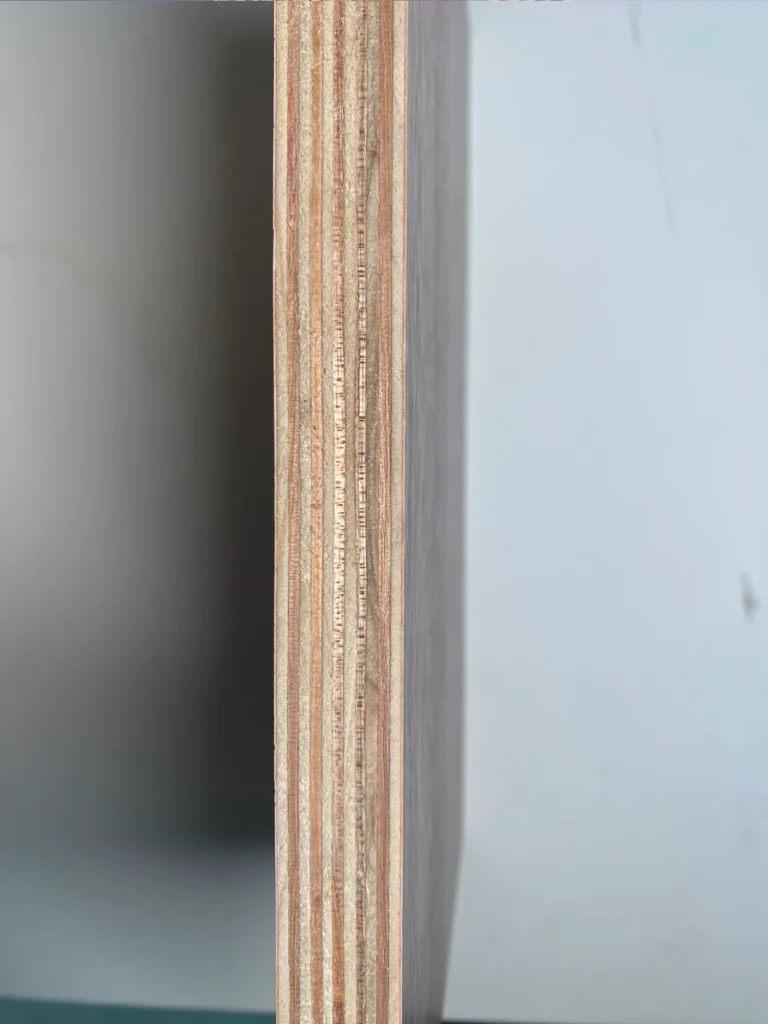Melamine plywood has become a popular choice in furniture-making, interior design, and construction due to its durability, moisture resistance, and affordability. This versatile material combines the strength of plywood with the protective benefits of melamine, offering a durable, aesthetically pleasing surface.、

How Melamine Plywood Is Made
Melamine plywood is created by layering a melamine coat onto a plywood core. The melamine layer is produced by combining melamine resin and formaldehyde through a polymerization process, resulting in a hard, plastic-like sheet that is durable and moisture-resistant. This melamine sheet is then bonded to the plywood using heat and pressure, creating a single, cohesive board with a smooth and protective surface.
Despite variations in core materials, the basic production process remains the same. However, core selection impacts the material’s performance and cost, making different types of melamine plywood suitable for various applications.
Types of Melamine Plywood: Core Material-Based Variations
The core material of melamine plywood significantly affects its properties, such as strength, durability, weight, and cost. Here’s a breakdown of the main types:

1. MDF Core (Medium-Density Fiberboard)
MDF core is composed of finely ground wood fibers mixed with resin and wax, then pressed under high heat to form panels. The MDF core provides a smooth surface ideal for melamine coating.
- Characteristics:
- Smooth surface
- Uniform density
- Cost-effective
- Heavyweight
- Easily cut and shaped
- Best Used For: Indoor furniture, cabinets, and interior design elements where aesthetics are a priority, as the smooth MDF surface allows for a flawless melamine finish.

2. Particle Board Core
Made from wood chips and sawdust bound together with glue, particle board core is a lightweight, budget-friendly option. This type is suitable for applications where high weight-bearing capacity isn’t required.
- Characteristics:
- Lightweight
- Thin and cost-effective
- Not water-resistant
- Best Used For: Cabinetry, shelving, and projects where the board will remain dry and won’t bear heavy loads.

3. Plywood Core
Comprising thin layers of wood stacked and glued with alternating grain directions, plywood core provides greater strength and stability. This type is more versatile, durable, and can withstand heavier loads and exposure to moisture better than MDF or particle board cores.
- Characteristics:
- Highly durable
- Wide range of applications
- Easily shaped, cut, and drilled
- Resistant to moisture
- Best Used For: Furniture, cabinetry, flooring, and DIY projects that require a strong, moisture-resistant material.
Advantages of Using Melamine Plywood
- Durability: Melamine plywood resists scratching, staining, and moisture, providing a longer-lasting surface compared to uncoated plywood.
- Aesthetic Appeal: Melamine plywood, available in a wide range of colors and finishes, gives projects a professional, polished look.
- Cost-Effectiveness: Melamine plywood is generally more affordable and available in large sheets than solid wood, minimizing waste.
- Easy Maintenance: The melamine coating is easy to clean, making it a practical choice for cabinetry and other high-use surfaces.
Choosing the Right Melamine Plywood for Your Project
Selecting the right melamine plywood depends on the intended application. Plywood core is ideal for demanding, high-moisture environments and projects requiring durability, while MDF core is perfect for achieving smooth, flawless finishes on indoor furniture. Particle board core is lightweight and suitable for simple cabinetry or shelving.
Final Thoughts
Melamine plywood is a versatile material that combines strength, visual appeal, and functionality, making it a top choice for both residential and commercial applications. By understanding the differences between core materials, you can select the most suitable melamine plywood for your needs, ensuring both beauty and durability in your projects.
